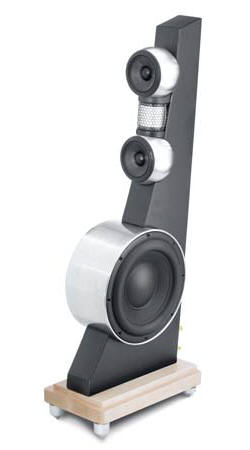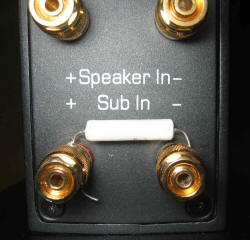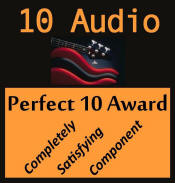Loudspeakers are not natural. Go outside and listen to a bird, or hear a piano, a French horn, a guitar, or even a drum. This is natural sound. Now listen to those same sounds on a typical loudspeaker where they are broken down into bass, midrange, and treble. The operative word here is “broken”. By the way, were you sitting in the sweet spot? Does a piano have a sweet spot?
When music is reproduced by every multi-way loudspeaker on the planet Earth, there are unnatural phase shifts at the frequencies where the woofer crosses over to the midrange driver and also where the midrange crosses over to the tweeter. Add additional anti-musical sonic pollution if the speakers have even more crossover points. These crossovers, which are made from inductors and capacitors and resistors, add unavoidable but serious distortion to the sound. Our hearing is sensitive enough to hear this distortion. However, it is a subtle effect that often takes several hours to become apparent.

“The Crossover Effect” makes you tense. It is similar to your preparation to hearing a loud sound, such as a gunshot or firecracker. Maintaining this tense, defensive posture makes you feel tired after a short time. The Crossover Effect also makes you want to turn down the volume. Less pain = better sound, yes? It is like hearing an old, worn out recording and then hearing the same music from a new, clean copy, where you turn off your internal scratch filter. Many loudspeaker manufacturers such as Merlin and Vandersteen and Wilson take this problem very seriously and spend a lot of time and effort – and additional cost to you – to deliver the least intrusive crossovers possible.
Well, that is fine and dandy. But the solution is not in building a better crossover. The solution is building a driver that does not require a crossover in the first place. “Wisdom is not in knowing all of the answers; it is asking the right questions.” Let us look at an imaginary 2-way speaker. It has a woofer that rolls off naturally and cleanly at 2000 Hz. The tweeter also rolls off naturally and cleanly at 2000 Hz and is not bothered by input signals below that frequency. The output levels per watt, or sensitivity, are the same. There are many other details to our imaginary speaker that will help to make it sound good, but so far, we do not need to use a crossover. Take one giant step forward!
Both of the dual midrange drivers and the tweeter of the Gallo Reference 3.1 are designed specifically for their respective roles in this particular speaker system. There is a single inductor for the woofer crossover and the low end of the midrange has a single crossover component for a smooth transition to the woofer. The tweeter uses a step-up/impedance matching transformer to increase its signal level and to reduce its characteristically high impedance. But there is no crossover between the midrange and the tweeter. This is the revolutionary genius of the Gallo Reference 3.1 loudspeaker. The result is that all frequencies from one octave below middle-C to 35kHz are uncommonly pure, integrated, and relaxed.
The unique “soda can” CDT tweeter, which is based on Anthony Gallo’s many years of research into piezo tweeter technology, has a 300 degree dispersion resulting in a listening window or sweet spot that is practically unlimited. If you are in front of the speakers and somewhere between them, you will get good to excellent sound. For the best imaging and most accurate sound stage, a more typical listening position is recommended.
The wide listening window makes toe-in adjustment for good imaging non-critical. Almost any speaker position from firing straight ahead to aiming at the listening chair offered good imaging and even frequency response. This is very important because the side-firing woofers will require careful attention to toe-in to provide balanced, even bass response in most rooms. In my room (you can probably expect your results to vary), a straight ahead position (rear of speakers parallel to rear wall) resulted in an even but weak bass response. With the speakers aimed directly at the listening position, the bass response was stronger but uneven, with the lower bass louder than the upper bass. Careful attention was required to align each speaker for the best bass response, positioning one speaker at a time while the other speaker was not playing. Since my setup is not symmetrical in the room, one speaker has a slightly different toe-in than the other speaker. In my room, I have the woofers firing outward and I see the inside face of the round woofer enclosure from the listening seat.
With this setup, the bass response is even and the speakers go very deep. I lived with and enjoyed powered subwoofers for several years, and yes, the powered subs go a bit deeper. I tried the Gallo SA Subwoofer Amplifier and felt that even though there were a few Hz more extension on the bottom, it is almost entirely unimportant to the music I listen to and enjoy. I will casually lump all of my preferred music into the category “soft rock”, but it includes some classical and jazz in the mostly studio rock music collection. Dire Straits, Joan Armatrading, Led Zeppelin, Jackson Browne, Doobie Brothers, Steely Dan, Supertramp, Jimmy Buffet, etc. No punk, rap, or grunge. You get the idea. My room is “L” shaped, about 20 x 12 x 8 feet. I have heard from owners with larger rooms who welcomed the added bass extension provided by the SA amplifier. The SA amp also has definite value in the context of a home theater system where synthetic effects are common.
Other components used for this review included the outstanding 500 wpc Cary 500MB and 150 wpc Quicksilver V4 amplifiers, connected to the speakers with PS Audio Resolution Reference or Audience Au24 speaker cables. My goal in installing the SA amplifier was not to get more bass extension, however. The powered subs I had been using offered a level of speed and bass definition that the Reference 3.1 on its own did not approach, much less equal. I felt that while the midrange and treble had all of the qualities of a true, high resolution reference loudspeaker, the bass was definitely the weak link in the overall sound. It simply did not match the impact and resolution of the midrange, creating a discontinuity at around 150 Hz and below. My thinking at the time was that connecting an amplifier, with its high damping factor, to the woofer’s second voice coil via the special pair of binding posts on the rear of the speaker might “tighten up” the bass so that its character would properly match the midrange.
It worked. The SA amplifier, after dialing it in with the high level inputs, enabled the bass of the Reference 3.1 to blend seamlessly with the midrange. The frequency setting was about 50 Hz (not critical) and the level was very low, just about one “hour” up from completely off. Mission accomplished, right? Well, not exactly. There is no free lunch, as the saying goes. I did not appreciate the noise from the SA amplifier’s cooling fan. The air intake is on the front panel, and the fan cycles on and off at regular intervals, a few minutes to each cycle. This soon became distracting, so I rocked the power switch and turned off the SA amplifier. On the next cut it was very apparent that the tight, detailed bass remained, but the bass power was diminished overall. There is a pattern here. The bass was nice and tight but weak with too much resistance (a turned off amplifier) across the subwoofer terminals, and relatively slow and loose with too little resistance (no connection) across the terminals. Hmmmm. Maybe if I adjusted this resistance to some optimal value, I could realize the very worthwhile benefits of the SA amplifier but without its penalties and added complexity. I had not been drinking on this particular evening.

Out came the big bag-o-resistors from my bygone speaker building experiments. I disconnected the SA amplifier and tried different resistors across the “Sub In” terminals with values ranging from 1 Ohm to 50 Ohms. This trial-and-error process ended when 15 ohm, 5 watt (or greater) wire wound resistors were installed and both the bass resolution and power locked in. Not just a good compromise: ideal. The 15 Ohm resistors have remained installed ever since and I have had no desire to either reinstall the SA amp or to revisit this issue. With this very simple and inexpensive tweak, the speakers “speak” with one voice from low bass to beyond the range of my hearing.
I have mentioned this in other reviews, but it is relevant considering the previous discussion. The loudspeaker and the listening room must be considered partners in the “bass system”. A speaker that provides excellent bass in one room may not work nearly as well in a room of different size or materials. I repeat this here because if you listen to these speakers and have the same impression of the bass character that I do, then the resistor tweak is definitely worth a try. If your room is very different and you love the bass of either the un-resistored speaker or with the SA amp, I will not be one bit surprised.
I had been using Magnepans for several years and with them enjoyed a very tall and wide sound stage. Several dynamic speakers that I brought in for comparisons during that period all had a sound stage that was like a sideways oval: tall in the middle and narrow on the sides near the speakers. This effect contributed to a distinctly artificial sound. The Gallos are not completely immune from this shortening towards the sides, but the effect is so minor that it is only noticed if I actively focus on it. The rearward tilt of the Reference 3.1s point the drivers directly at my listening height, so the sound field is properly “focused” in my room. Standing up reduces high frequencies to a lesser degree than with many other speakers. There are at least a couple of aftermarket stands that raise the speakers 10-12 inches off of the floor and are reported to expand the vertical sound stage even more. These are all box-type stands that fit under the Gallo’s high-density maple base. This base is attached to the cast-aluminum “enclosure” with six machine bolts. Here is a challenge for someone with construction skills: make a narrow stand/riser that fits between the aluminum enclosure and the large base. It should simply bolt into place.
Even though the speakers are only 35 inches tall, please do not assume that stands are required or will necessarily offer a positive improvement. The adjustable front spikes are taller than the rear spikes (also adjustable), so the normal rearward tilt of the speakers will offer an optimum sound field in most small to medium sized rooms where the listening seat is 7-15 feet from the speakers.
The Gallo Reference 3.1 is a true reference loudspeaker. It has high power handling and can easily play louder than I care to listen. This offers undistorted headroom and often intense dynamic impact. It has very high resolution from the low bass to beyond hearing, offering remarkable insight into the musical message. It is both an excellent tool for reviewers or analytical listeners, and an involving music-making instrument. It has a wide listening window, letting you share the experience. It is small, lightweight, and easy to drive with a wide range of amplifiers, although I suggest about a 100 watt minimum to realize the wide dynamic range of which this speaker is capable. It is also a tremendous bargain at $3000. The Reference 3.1 is entirely enjoyable, letting me relax into the music and forget about the technology for hours and hours on end. It is not just a reference loudspeaker, it is my reference loudspeaker.
Overall Rating: 10 LPs

Link to Gallo Acoustics
